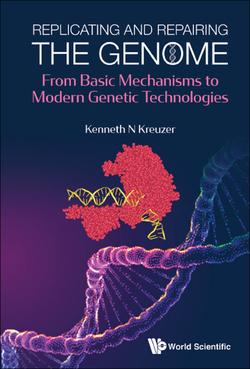Читать книгу Replicating And Repairing The Genome: From Basic Mechanisms To Modern Genetic Technologies - Kenneth N Kreuzer - Страница 6
На сайте Литреса книга снята с продажи.
Preface
ОглавлениеThousands of scientists studying DNA replication and repair over the last half century have uncovered an amazing wealth of information using numerous experimental systems, and thereby illuminated the very reactions that are necessary for life on our planet. However, this wealth of information is complex and dense, particularly since the fields are rife with terminology that often differs between experimental systems, and since many of the pathways are interconnected with other cellular pathways. Thus, the fields are difficult for a newcomer to appreciate and master. The intent of this book is to describe the logic and mechanisms involved in replication and repair within a reasonable and concise framework, avoiding much of the dense information and terminology that can make the field seem opaque.
While the main text will generally not attempt to provide the experimental designs and details behind the science, inserts called “How did they test that?” are included at the end of each chapter to illustrate some of the beautiful experimental approaches that uncovered key aspects of DNA replication and repair. These can be jumping-off points for readers to delve into primary literature in the field.
I should note that there are recent outstanding textbooks and specialized compendiums that present the fields in much finer and complete detail. These are listed in the Further Reading section of Chapter 1 (and other Chapters), and are highly recommended for those who will engage more deeply in specific areas of DNA replication and repair. The Further Reading sections also contain citations to a few key papers from the primary literature, including those highlighted in the “How did they test that?” inserts, as well as review articles that cover Chapter topics in more detail.
The internet provides many valuable resources relevant to the topics covered, along with sites for conducting literature searches (PubMed, Google Scholar, etc). Many informative animations of key processes can be found on YouTube (www.youtube.com). The Nobel Prize web site (www.nobelprize.org) has more information on the various Nobel Prizes highlighted in this book, and in some cases, the Nobel Prize lectures associated with the Prizes.
Regarding protein function, structure and nomenclature, the following resources are very useful. The Universal Protein Resource (www.UniProt.org) is a collection of databases and information organized collaboratively by the European Bioinformatics Institute, the Swiss Institute of Bioinformatics, and the Protein Information Resource. The web site is a front end for vast amounts of information on protein nomenclature, sequences, relationships, and functions, as well as relevant citations. The Protein Data Bank (www.rcsb.org)1 provides access to structures of proteins and protein-DNA complexes, with a highly interactive interface that allows many different structural display options, 360° rotations, zooming, and the key primary reference(s) relevant for the particular protein or protein-DNA complex. A free web-based structure visualization system with many advantages (including the ability to save and share particular views as a URL) has recently been deployed and is also highly recommended: iCn3D (I-see-in-3D)2; see web site https://www.ncbi.nlm.nih.gov/Structure/icn3d/docs/icn3d_about.html.
1Berman, H.M., Westbrook, J., Feng, Z., Gilliland, G., Bhat, T.N., Weissig, H., Shindyalov, I.N., and Bourne, P.E. (2000). The Protein Data Bank. Nucleic Acids Research 28:235–242.
2Wang, J., Youkharibache, P., Zhang, D., Lanczycki, J., Geer, R.C., Madej, T., Phan, L., Ward, M., Lu, S., Marchler, G.H., Wang, Y., Bryant, S.H., Geer, L.Y., and Marchler-Bauer, A. (2019). iCn3D, a web-based 3D viewer for sharing 1D/2D/3D representations of biomolecular structures. Bioinformatics, doi:10.1093/bioinformatics/btz502.
